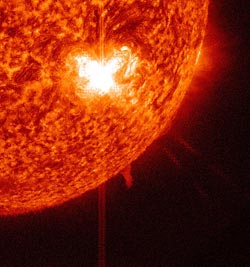Another M-class Flare from Sunspot 1515

The Solar Dynamics Observatory (SDO) captured this image of the sun during an M6.1 flare that peaked at 7:44 AM EDT on July 5, 2012. The image is shown in the 304 Angstrom wavelength, which is typically colorized in red. Credit: NASA/SDO/AIA <br>
Radio blackouts occur when the X-rays or extreme UV light from a flare disturb the layer of Earth's atmosphere known as the ionosphere, through which radio waves travel. The constant changes in the ionosphere change the paths of the radio waves as they move, thus degrading the information they carry.
This affects both high and low frequency radio waves alike. Radio blackouts are rated on a scale from R1 (minor) to R5 (extreme). An R2 radio blackout can result in limited degradation of both high- and low-frequency radio communication and GPS signals.
The same region has also produced numerous coronal mass ejections or CMEs. They have been observed and modeled by NASA's Space Weather Center (SWC) and are thought to be moving relatively slowly, traveling between 300 and 600 miles per second. Since the active region itself is so southerly in the sun, CMEs from this region are generally unlikely to impact Earth.
The strongest flares are classified as X-class, while M-class flares are the second strongest classification. Classified as an M6.1, this latest flare is a little over half the size of the weakest X-class flares.
For more information on flare classification, visit http://www.nasa.gov/mission_pages/sunearth/news/X-class-flares.html.
What is a solar flare? What is a coronal mass ejection?
For answers to these and other space weather questions, please visit the Spaceweather Frequently Asked Questions page.
Karen C. Fox
NASA Goddard Space Flight Center, Greenbelt, MD
Media Contact
All latest news from the category: Physics and Astronomy
This area deals with the fundamental laws and building blocks of nature and how they interact, the properties and the behavior of matter, and research into space and time and their structures.
innovations-report provides in-depth reports and articles on subjects such as astrophysics, laser technologies, nuclear, quantum, particle and solid-state physics, nanotechnologies, planetary research and findings (Mars, Venus) and developments related to the Hubble Telescope.
Newest articles

A universal framework for spatial biology
SpatialData is a freely accessible tool to unify and integrate data from different omics technologies accounting for spatial information, which can provide holistic insights into health and disease. Biological processes…

How complex biological processes arise
A $20 million grant from the U.S. National Science Foundation (NSF) will support the establishment and operation of the National Synthesis Center for Emergence in the Molecular and Cellular Sciences (NCEMS) at…

Airborne single-photon lidar system achieves high-resolution 3D imaging
Compact, low-power system opens doors for photon-efficient drone and satellite-based environmental monitoring and mapping. Researchers have developed a compact and lightweight single-photon airborne lidar system that can acquire high-resolution 3D…





















